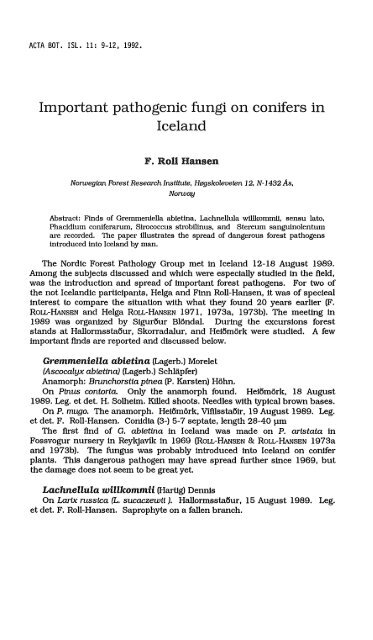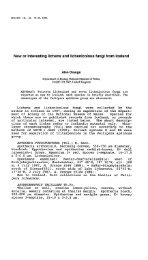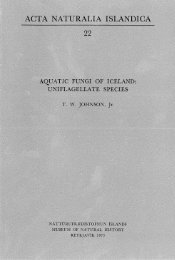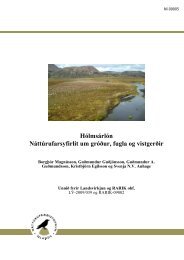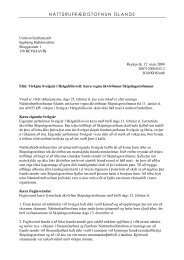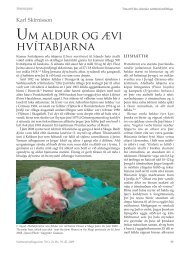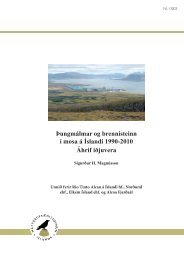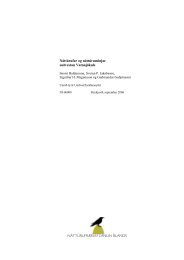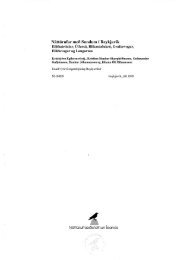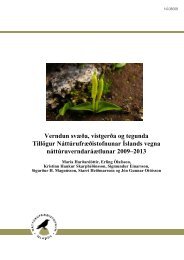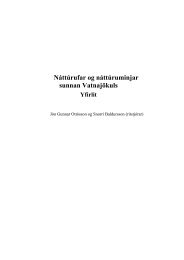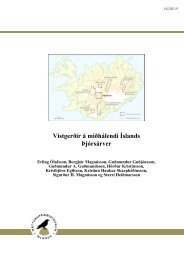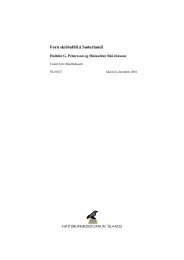Important pathogenic fungi on conifers in Iceland
Important pathogenic fungi on conifers in Iceland
Important pathogenic fungi on conifers in Iceland
You also want an ePaper? Increase the reach of your titles
YUMPU automatically turns print PDFs into web optimized ePapers that Google loves.
ACTA BOT. ISL. 11: 9-12, 1992.<br />
<str<strong>on</strong>g>Important</str<strong>on</strong>g> <str<strong>on</strong>g>pathogenic</str<strong>on</strong>g> <str<strong>on</strong>g>fungi</str<strong>on</strong>g> <strong>on</strong> c<strong>on</strong>ifers <strong>in</strong><br />
<strong>Iceland</strong><br />
F. Roll Hansen<br />
N<strong>on</strong>veglan Fbrest Research Institute, H0gskoleveien 12, N·1432 As.<br />
N<strong>on</strong>vay<br />
Abstract: F<strong>in</strong>ds of Gremmeniella abiet<strong>in</strong>a. Lachnellula willkommii. sensu lato.<br />
Phacidium c<strong>on</strong>iferarum. Sirococcus strobil<strong>in</strong>us, and Stereum sangu<strong>in</strong>olentum<br />
are recorded. The paper illustrates the spread of dangerous forest pathogens<br />
<strong>in</strong>troduced <strong>in</strong>to <strong>Iceland</strong> by man.<br />
The Nordic Forest Pathology Group met <strong>in</strong> <strong>Iceland</strong> 12-18 August 1989.<br />
Am<strong>on</strong>g the subjects discussed and which were especially studied <strong>in</strong> the field.<br />
was the <strong>in</strong>troducti<strong>on</strong> and spread of important forest pathogens. For two of<br />
the not <strong>Iceland</strong>ic participants, Helga and F<strong>in</strong>n Roll-Hansen. it was of spec1eal<br />
<strong>in</strong>terest to compare the situati<strong>on</strong> With what they found 20 years earlier (F.<br />
ROIL-HANSEN and Helga ROLL-HANsEN 1971. 1973a, 1973b). The meet<strong>in</strong>g <strong>in</strong><br />
1989 was organized by Siguri5ur Bl5ndal. Dur<strong>in</strong>g the excursi<strong>on</strong>s forest<br />
stands at Hallormsstai5ur, Skorradalur. and Heii5mork were studied. A few<br />
important f<strong>in</strong>ds are reported and discussed below.<br />
Gremmeniella abiet<strong>in</strong>a (Lagerb.) Morelet<br />
(Ascocalyx ablet<strong>in</strong>a) (Lagerb.) Schlapfer)<br />
Anamorph: Brunchorstia p<strong>in</strong>ea (p. Karsten) Hohn.<br />
On P<strong>in</strong>us c<strong>on</strong>torta. Only the anamorph found. Heii5m5rk, 18 August<br />
1989. Leg. et det. H. Solheim. Killed shoots. Needles With typical brown bases.<br />
On P. mugo. The anamorph. Heii5m5rk, VIftlsstai5ir, 19 August 1989. Leg.<br />
et det. F. Roll-Hansen. C<strong>on</strong>idia (3-) 5-7 septate. length 28-40 pm<br />
The first f<strong>in</strong>d of G. ablet<strong>in</strong>a <strong>in</strong> <strong>Iceland</strong> was made <strong>on</strong> P. aristata <strong>in</strong><br />
Fossvogur nursery <strong>in</strong> Reykjavik <strong>in</strong> 1969 (ROLL-HANSEN & ROIL-HANsEN 1973a<br />
and 1973b). The fungus was probably <strong>in</strong>troduced <strong>in</strong>to <strong>Iceland</strong> <strong>on</strong> c<strong>on</strong>ifer<br />
plants. This dangerous pathogen may have spread further s<strong>in</strong>ce 1969, but<br />
the damage does not seem to be great yet.<br />
Lachnellula willkommii (Hartig) Dennis<br />
On Larix russtca (L. sucaczewii). Hallormsstai5ur. 15 August 1989. Leg.<br />
et det. F. Roll-Hansen. Saprophyte <strong>on</strong> a fallen branch.
On L. rnssica. Hall<strong>on</strong>nsstaOur, 15 August 1989. Leg. et det. F. Roll<br />
Hansen and K. Venn. Parasite <strong>on</strong> a few liv<strong>in</strong>g branches <strong>on</strong> two liv<strong>in</strong>g trees.<br />
On L. rnssica. Skorradalur 17 August 1989. Leg. et det. F. Roll-Hansen.<br />
Apparently a parasite <strong>on</strong> a liv<strong>in</strong>g twig. and possibly a pure saprophyte <strong>on</strong> a<br />
dead twig <strong>on</strong> the same tree.<br />
The first f<strong>in</strong>d of L. willkommii <strong>in</strong> <strong>Iceland</strong> was made <strong>on</strong> L. rnssica at<br />
Hall<strong>on</strong>nsstaOur <strong>in</strong> 1969 <strong>on</strong> a dead, fallen branch (RoLL-HANSEN & ROLL-HANSEN<br />
1973). The fungus was then named L. willkommii var. hahniana, and later<br />
identified as L. occidentalis (Hahn & Ayers) Dharne (L. hahniana (Seaver)<br />
Dennis). Probably the same fungus was later found <strong>on</strong> the same host at the<br />
same locality by Gotzsche and identified as L. occidentalis by D.K. Brenl2le(<br />
pers. comm. Helgi Hallgrimss<strong>on</strong>). I f<strong>in</strong>d it difficult to dist<strong>in</strong>guish between a<br />
parasitic L. willkommtl and a saprophytic L. occidentalis. ROSAK (1952) made<br />
thorough comparis<strong>on</strong>s and found small differences; he c<strong>on</strong>cluded that they<br />
may be c<strong>on</strong>sidered varities of <strong>on</strong> species. I have not dist<strong>in</strong>guished between<br />
the two taxa here. The species must have been <strong>in</strong>troduced by man.<br />
Phacidium c<strong>on</strong>iferarum (Hahn) DiCosmo, Nag Raj & Kendrick<br />
(Potebniamyces c<strong>on</strong>iferarnm (Hahn) Smerlis)<br />
Anamorph: Phacldlopycnis pseudDtsugae (M. Wils<strong>on</strong>) Hahn. Only the<br />
anamorph was found.<br />
On Larfx rnssica. Hall<strong>on</strong>nsstaOur. 15 August 1989. Leg. The Nordic<br />
Forest Pathology Group. det. F. Roll-Hansen.<br />
On P<strong>in</strong>us mugo. HeiOmork. VtftlsstaOir, 18 August 1989 Leg. et det. F.<br />
Roll-Hansen.<br />
On P. sylvestris. HeiOmork. VifilsstaOir. 18 August 1989. Leg. et det. F.<br />
Roll-Hansen.<br />
A~ Skorradalur we saw extensive kill<strong>in</strong>g of the bark around wounds <strong>on</strong><br />
stems of P<strong>in</strong>us c<strong>on</strong>torta after prun<strong>in</strong>g <strong>in</strong> the late fall. The fungus was<br />
probably <strong>in</strong>troduced by man <strong>on</strong> c<strong>on</strong>ifer plants.<br />
Phacidlopycnis pseudDtsugae was found <strong>in</strong> 1969 <strong>on</strong> Larfx rnssica at<br />
Hall<strong>on</strong>nsstaOur, near M)ivatn. and at Skorradalur ; aO Hall<strong>on</strong>nsstaOur it was<br />
also found <strong>on</strong> Picea pungens (ROLL-HANSEN & ROLL-HANsEN 1971. 1973a.<br />
1973b). The fungus was found to be very damag<strong>in</strong>g to larch. especially after<br />
wound<strong>in</strong>g <strong>in</strong> the rest period of the tree, but it also <strong>in</strong>fected the stem through<br />
small branches killed by frost.<br />
Sirococcus strobil<strong>in</strong>us Preuss<br />
(Ascochyta p<strong>in</strong>iperda L<strong>in</strong>dau)<br />
On Lartx rnssica. Skorradalur. 17 August 1989. Leg. et det. F. Roll<br />
Hansen.<br />
The c<strong>on</strong>idia were l<strong>on</strong>ger than given by most authors; I found a length of<br />
15-21 pm. But ROSAK (1956) recorded that still greater lengths can be found.<br />
The fungus is a parasite <strong>on</strong> c<strong>on</strong>ifers. Damag<strong>in</strong>g attacks have ben found <strong>on</strong><br />
c<strong>on</strong>torta plants <strong>in</strong> nurseries ROLL-HANSEN (1978). The fungus was probably<br />
<strong>in</strong>troduced by man.
Stereum sangu<strong>in</strong>olentum (Alb. & Schw.: Fr.)Fr.<br />
On Larix russica. Hall<strong>on</strong>nsstaiSur, Gutt<strong>on</strong>nslundur, 15 August 1989.<br />
Leg. et det. F. Roll-Hansen, H. Solheim, and K. Venn.<br />
On P<strong>in</strong>us c<strong>on</strong>torta. Skorradalur 17 August 1989. Leg. et det. H. Solheim.<br />
On Pseudotsuga menziesii. Hall<strong>on</strong>nsstaiSur, 15 August 1989. Leg. et det.<br />
F. Roll-Hansen.<br />
On all three hosts the fungus was found <strong>on</strong> stumps. The fruit bodies were<br />
bleed<strong>in</strong>g when wounded. But <strong>on</strong> closer exam<strong>in</strong>ati<strong>on</strong> they did not seem to be<br />
active at the moment; spores and acanthocystidia were not found. The<br />
fungus was identified as S. sanguiolentum (not S. rugosum) because of the<br />
substrate and because the fruit bodies were th<strong>in</strong>, with tissue f<strong>on</strong>ned <strong>on</strong>ly <strong>in</strong><br />
<strong>on</strong>e seas<strong>on</strong>.<br />
In 1969 the fungus was found <strong>on</strong> P<strong>in</strong>us mugo near Akureyri (RoLL-HANsEN<br />
& ROLL-HANsEN 1973a, 1973b). This is, however, not the first f<strong>in</strong>d of the<br />
fungus <strong>in</strong> <strong>Iceland</strong>; Helgi Hallgrimss<strong>on</strong> has <strong>in</strong>f<strong>on</strong>ned me that he found Stereum<br />
sangu<strong>in</strong>olentum already <strong>in</strong> 1961 at Grund <strong>in</strong> EyjafjoriSur. This c<strong>on</strong>ifer fungus<br />
is known from other countries to cause much damage both as a wound<br />
parasite, and as a rot fungus <strong>in</strong> stored timber. It was probably <strong>in</strong>troduced<br />
<strong>in</strong>to <strong>Iceland</strong> by man. Now it is widely spread.<br />
Gremmeniella abiettna, Lachnellula willkomii, Phacidium c<strong>on</strong>iferarum,<br />
Sirococcus strobil<strong>in</strong>us, and Stereum sangu<strong>in</strong>olentum are important forest<br />
pathogens, and all of them have probably been <strong>in</strong>troduced by man. They<br />
may have been <strong>in</strong>troduced <strong>on</strong> <strong>in</strong>fected liv<strong>in</strong>g c<strong>on</strong>iferous plants, perhaps from<br />
Norway, when import of plants was without c<strong>on</strong>trol. The damage made <strong>in</strong><br />
<strong>Iceland</strong> by these <str<strong>on</strong>g>fungi</str<strong>on</strong>g> has not been dramatic, so far; greatest loss have been<br />
recorded by Ph. c<strong>on</strong>iferarum <strong>on</strong> Larix russica. But <strong>on</strong>ly <strong>on</strong>e stra<strong>in</strong>, or a few<br />
stra<strong>in</strong>s, of the <str<strong>on</strong>g>fungi</str<strong>on</strong>g> may yet have been <strong>in</strong>troduced: The pathogical picture of<br />
L. willkommit <strong>on</strong> Larix <strong>in</strong> <strong>Iceland</strong> seems unif<strong>on</strong>n and, so far, not dangerous.<br />
Our great number of pure culture isolates of Ph. c<strong>on</strong>iferarum from <strong>Iceland</strong> <strong>in</strong><br />
1969 were all equal, whereas Norwegian isolates show great variati<strong>on</strong>. More<br />
dangerous stra<strong>in</strong>s ofthe <str<strong>on</strong>g>fungi</str<strong>on</strong>g> treated above may be <strong>in</strong>troduced <strong>in</strong> the future.<br />
There are other fungal pathogens which way be dangerous to trees <strong>in</strong><br />
<strong>Iceland</strong>, but which seem not to have been <strong>in</strong>troduced yet. Heterobasidi<strong>on</strong><br />
annosum is an example; the rather low temperature <strong>in</strong> <strong>Iceland</strong> may h<strong>in</strong>der<br />
the spread, but we do not know. Other examples both <strong>on</strong> c<strong>on</strong>ifers and <strong>on</strong><br />
broadleaf trees are numerous rot <str<strong>on</strong>g>fungi</str<strong>on</strong>g> and rust <str<strong>on</strong>g>fungi</str<strong>on</strong>g>.<br />
It may be right as far as possible to try to prevent <strong>in</strong>troducti<strong>on</strong> <strong>in</strong>to <strong>Iceland</strong><br />
of new stra<strong>in</strong>s of dangerous fungal species which have already been<br />
<strong>in</strong>troduced, as well as ofspecies which have not yet been <strong>in</strong>troduced.<br />
REFERENCES<br />
Robak, H. 1952. Om saprotyttlske og parasittlske raser av lerkekreftsoppen, Dasyscypha<br />
wUUcommti (Hart.)Rehm. Meddr Vestland. forstl. Forsstn 9: 113-211<br />
Robak, H. 1956. Some <str<strong>on</strong>g>fungi</str<strong>on</strong>g> occurr<strong>in</strong>g <strong>on</strong> died-back tops and branches of Plcea abies<br />
and Abies ssp. <strong>in</strong> Western Norway. Frlesia 5: 366-389
12 ACTA BOTANICA ISLANDICA NO 11<br />
Roll-Hansen, F. 1978. Fungi dangerous at Pirms c<strong>on</strong>torta with special reference to<br />
pathogens from North Europe. Eur. J. For. Pat. 8:1-14<br />
Roll-Hansen, F. & Roll-Hansen. H. 1971. Potebntamyces c<strong>on</strong>iferarum Literature Review.<br />
Occurrence <strong>on</strong> LaJix russica<strong>in</strong> <strong>Iceland</strong>. Meddr norske SkogforsVes. 109(9): 527-556<br />
Roll-Hansen. F. & Roll-Hansen, H. 1073a. Litt om skogsykdommer og ri'ttesopper i<br />
Island. (Notes <strong>on</strong> forest diseases and rot <str<strong>on</strong>g>fungi</str<strong>on</strong>g> <strong>in</strong> <strong>Iceland</strong>). Tidsskr. Skogbr. 81:73-79<br />
Roll-Hansen, F. & Roll-Hansen. H. 1973b. Stutt yflrlit urn nokkra trjasjUkdoma og<br />
fUasveppi a Island!. Arsrit skogrrektarfelags Islands 1972-1973: 46-50


